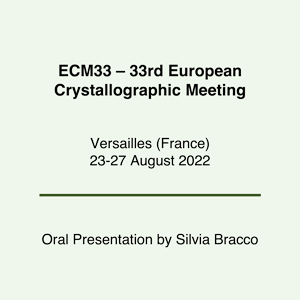Versailles (France), 23-27 August 2022, Oral Presentation by Silvia Bracco
Title: “Ultra-Fast Rotor Dynamics and Gas Reorientation in Crystalline Nanoporous Architectures”
Authors: S. Bracco, C. X. Bezuidenhout, J. Perego, S. Piva, A. Daolio, A. Comotti and P. Sozzani
Abstract
Crystalline nanoporous architectures offer stimulating opportunities in designing rotors and motors in the solid state and exploring sorptive properties and gas transport. Molecular rotors in the solid state have been successfully engineered in porous materials, such as Metal Organic Frameworks (MOFs), thanks to their large free volume, which allows for fast dynamics. In particular, a ultra-fast molecular rotor, whose rotation speed approaches that of unhindered rotations in organic moieties even at very low temperatures, has been realized.(1) The rotor based on bicyclo[1.1.1]pentane–dicarboxylate (BCP) moiety was installed in the 3D cubic structure of a highly porous Zn-MOF, thus isolating the individual rotor from each another (Fig. 1a, b). Solid state NMR relaxation measurements 1H T1 and muon-spin spectroscopy(2) performed at temperatures as low as 2 K allowed the determination of an activation energy as low as 6.2 cal mol-1, consistent with fast molecular reorientation in the GHz regime even at the lowest temperatures. Furthermore, pillared-MOFs built from two distinct ultrafast and interacting molecular rotors form a multidynamical architecture wherein the rotors experience sequential motional behaviour activated at distinct temperatures. The manipulation by chemical stimuli, such as CO2, which diffused from the gas phase into the porous matrix, resulted in the selective control over rotary dynamics.(3) CO2 diffusion in a porous crystalline material, in which the channels are decorated by double helices of electrostatic charges, has been described by solid state NMR. The remarkable CO2-matrix association allowed direct observation of the gas exploring the nanochannels and the identification of the specific interaction sites by 2D 1H-13C HETCOR MAS NMR experiments (Fig. 2), providing peculiar details about the role of electrostatic interactions in gas transport phenomena. The sorption performances and the extraordinary thermal stability up to 450 °C highlighted the perspective of applying these materials for selective removal of CO2 from other gases.(4) References 1) J. Perego, S. Bracco, M. Negroni, C. X. Bezuidenhout, G. Prando, P. Carretta, A. Comotti, and P. Sozzani, Nat. Chem. 2020, 12, 845. 2) G. Prando, J. Perego, M. Negroni, M. Riccò, S. Bracco, A. Comotti, P. Sozzani, P. Carretta, Nano Lett. 2020, 20, 7613. 3) J. Perego, C. Bezuidenhout, S. Bracco, G. Prando, L. Marchio’, M. Negroni, P. Carretta, P. Sozzani, A. Comotti J. Am. Chem. Soc. 2021, 143, 13082. 4) G. Xing, I. Bassanetti, S. Bracco, M. Negroni, C. Bezuidenhout, T. Ben, P. Sozzani, A. Comotti, Chemical Science 2019, 10, 730.

